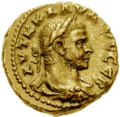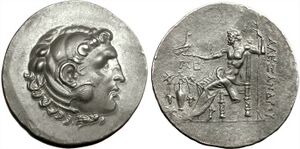علم المسكوكات
| جزء من سلسلة عن |
| علم المسكوكات دراسة العملات |
|---|
 |
| العملات المحلية |
| العملات الخيالية |
| التاريخ |
| العملات التاريخية |
| البيزنطية |
| عملات العصور الوسطى |
| الانتاج |
| Exonumia |
| Notaphily |
| Scripophily |
|
|
علم المسكوكات Numismatics هو دراسة أو جمع النقود، العملات، الأوسمة، tokens، exonumia والأوراق النقدية.
Specialists, known as numismatists, are often characterized as students or collectors of coins, but the discipline also includes the broader study of money and other means of payment used to resolve debts and exchange goods.

The earliest forms of money used by people are categorised by collectors as "odd and curious",[1] but the use of other goods in barter exchange is excluded, even where used as a circulating currency (e.g., cigarettes or instant noodles in prison).[2] As an example, the Kyrgyz people used horses as the principal currency unit, and gave small change in lambskins;[3] the lambskins may be suitable for numismatic study, but the horses are not.[محل شك] Many objects have been used for centuries, such as cowry shells, precious metals, cocoa beans, large stones, and gems.
History of money
Throughout its history, money itself has been made to be a scarce good, although it does not have to be.[بحاجة لمصدر] Many materials have been used to form money, from naturally scarce precious metals and cowry shells through cigarettes to entirely artificial money, called fiat money, such as banknotes. Many complementary currencies use time as a unit of measure, using mutual credit accounting that keeps the balance of money intact.
Modern money (and most ancient money too) is essentially a token – an abstraction. Paper currency is perhaps the most common type of physical money today. However, goods such as gold or silver retain many of the essential properties of money, such as price fluctuation and limited supply. However, these goods are not controlled by one single authority.
تاريخ علم المسكوكات
Coin collecting may have possibly existed in ancient times. Augustus gave "coins of every device, including old pieces of the kings and foreign money" as Saturnalia gifts.[4]
Petrarch, who wrote in a letter that he was often approached by vine diggers with old coins asking him to buy or to identify the ruler, is credited as the first Renaissance collector. Petrarch presented a collection of Roman coins to Emperor Charles IV in 1355.
The first book on coins was De Asse et Partibus (1514) by Guillaume Budé.[5] During the early Renaissance ancient coins were collected by European royalty and nobility. Collectors of coins were Pope Boniface VIII, Emperor Maximilian of the Holy Roman Empire, Louis XIV of France, Ferdinand I, Elector Joachim II of Brandenburg who started the Berlin coin cabinet and Henry IV of France to name a few. Numismatics is called the "Hobby of Kings", due to its most esteemed founders.
Professional societies organised in the 19th century. The Royal Numismatic Society was founded in 1836 and immediately began publishing the journal that became the Numismatic Chronicle. The American Numismatic Society was founded in 1858 and began publishing the American Journal of Numismatics in 1866.
In 1931 the British Academy launched the Sylloge Nummorum Graecorum publishing collections of Ancient Greek coinage. The first volume of Sylloge of Coins of the British Isles was published in 1958.
In the 20th century, coins gained recognition as archaeological objects, and scholars such as Guido Bruck of the Kunsthistorisches Museum in Vienna realized their value in providing a temporal context and the difficulty that curators faced when identifying worn coins using classical literature. After World War II in Germany, a project, Fundmünzen der Antike (Coin finds of the Classical Period) was launched to register every coin found within Germany. This idea found successors in many countries.
In the United States, the US Mint established a coin cabinet in 1838 when chief coiner Adam Eckfeldt donated his personal collection.[6] William E. Du Bois' Pledges of History... (1846) describes the cabinet.
C. Wyllys Betts' American colonial history illustrated by contemporary medals (1894) set the groundwork for the study of American historical medals.
Helen Wang's "A short history of Chinese numismatics in European languages" (2012–2013) gives an outline history of Western countries' understanding of Chinese numismatics.[7] Lyce Jankowski's Les amis des monnaies is an in-depth study of Chinese numismatics in China in the 19th century.[8]
Modern numismatics
Modern numismatics is the study of the coins of the mid-17th century onward, the period of machine-struck coins.[9] Their study serves more the need of collectors than historians, and it is more often successfully pursued by amateur aficionados than by professional scholars. The focus of modern numismatics frequently lies in the research of production and use of money in historical contexts using mint or other records in order to determine the relative rarity of the coins they study. Varieties, mint-made errors, the results of progressive die wear, mintage figures, and even the sociopolitical context of coin mintings are also matters of interest.
Subfields
Exonumia (UK English: Paranumismatica)[10] is the study of coin-like objects such as token coins and medals, and other items used in place of legal currency or for commemoration. This includes elongated coins, encased coins, souvenir medallions, tags, badges, counter-stamped coins, wooden nickels, credit cards, and other similar items. It is related to numismatics proper (concerned with coins which have been legal tender), and many coin collectors are also exonumists.
Notaphily is the study of paper money or banknotes. It is believed that people have been collecting paper money for as long as it has been in use. However, people only started collecting paper money systematically in Germany in the 1920s, particularly the Serienscheine (Series notes) Notgeld. The turning point occurred in the 1970s when notaphily was established as a separate area by collectors. At the same time, some developed countries such as the United States, Germany, and France began publishing their respective national catalogs of paper money, which represented major points of reference literature.
Scripophily is the study and collection of companies' shares and bonds certificates. It is an area of collecting due to both the inherent beauty of some historical documents as well as the interesting historical context of each document. Some stock certificates are excellent examples of engraving. Occasionally, an old stock document will be found that still has value as stock in a successor company.
قائمة مجموعات المسكوكات المعروضة علناً
قائمة أهم علماء المسكوكات
|
|
انظر أيضاً
- جمع العملات
- Coin grading
- Coin catalog
- Glossary of numismatics
- American Numismatic Association
- American Numismatic Society
- American Israel Numismatic Association
- International Association of Professional Numismatists
- Royal Numismatic Society
- Swiss Numismatic Society
- Joseph Pellerin
- Commodity money
- Money creation
- Where's George?
- Where's Willy?
- Auction catalog
- Exchange rate
- Manillas – a form of primitive or archaic money.
- World Money Fair
- Leper colony money
- List of most expensive coins
الهامش
- ^ Maurer, B. "Primitive and Nonmetallic Money". In Yago, K.; Battilosi, S.; Cassis., Y. (eds.). Handbook of the History of Money and Currency. Springer. p. 87-104.
- ^ Gibson-Light, Michael (2018-06-01). "Ramen Politics: Informal Money and Logics of Resistance in the Contemporary American Prison". Qualitative Sociology (in الإنجليزية). 41 (2): 199–220. doi:10.1007/s11133-018-9376-0. ISSN 1573-7837. S2CID 254976793.
- ^ Glyn Davies (1996). Chronology of Money 1900 — 1919. University of Wales Press. ISBN 978-0-7083-1351-0. Archived from the original on 2006-07-14. Retrieved 2006-08-09.
- ^ Suetonius, Augustus 75 on-line text Archived 2022-07-31 at the Wayback Machine
- ^ Brigham Young University library web page Archived 2008-07-25 at the Wayback Machine
- ^ Kent, Allen (1985). Encyclopedia of Library and Information Science. p. 281. ISBN 978-0-8247-2037-7.
- ^ Helen Wang, "A short history of Chinese numismatics in European languages", in Early China vols 35-36 (2012–2013), pp. 395-429,
- ^ Jankowski, Lyce (2018). Les amis des monnaies – la sociabilité savante des collectionneurs et numismates chinois de la fin des Qing. Paris: Maisonneuve et Larose nlle édition. ISBN 978-2-37701-030-1.
- ^ "Collectibles". Maritime International. Archived from the original on September 14, 2013. Retrieved June 13, 2013.
- ^ The First Dictionary of Paranumismatica: All About Tokens, Checks, Tickets, Passes, Medalets, Counters, Tallies and Weights (ed. Brian Edge), 1991. ISBN 978-0951691007
- ^ Museum Special: China Numismatic Museum CCTV News – CNTV English. . Retrieved on 2011-11-24.
- ^ IMES BOJ Currency Museum TOP. Imes.boj.or.jp. Retrieved on 2011-11-24.
- ^ University of Glasgow :: Collections :: Collections Summary :: Coins and Medals. Gla.ac.uk. Retrieved on 2011-11-24.
- ^ Money. Manchester Museum
- ^ Mitglieder der Numismatischen Kommission (ÖAW). Oeaw.ac.at (2008-12-19). Retrieved on 2011-11-24.
- ^ Mark Blackburn obituary | Education. The Guardian. Retrieved on 2011-11-24.
- ^ obituaries « A Corner of Tenth-Century Europe. Tenthmedieval.wordpress.com. Retrieved on 2011-11-24.
- ^ Mark Blackburn. Telegraph. Retrieved on 2011-11-24.
- ^ أ ب Dr Andrew Burnett – British Academy. Britac.ac.uk. Retrieved on 2011-11-24.
- ^ Joe Cribb. British Museum. Retrieved on 2011-11-24.
- ^ John Morcom (July 28, 2005). "Obituary: Kenneth Jenkins". The Guardian. Retrieved June 13, 2013.
- ^ Francois Thierry | Bibliothèque nationale de France – Academia.edu. Bnf.academia.edu. Retrieved on 2011-11-24.
وصلات خارجية
 The Wiktionary definition of numismatics
The Wiktionary definition of numismatics Media related to Numismatics at Wikimedia Commons
Media related to Numismatics at Wikimedia Commons
- Short description is different from Wikidata
- Portal-inline template with redlinked portals
- Pages with empty portal template
- مقالات ذات عبارات محل شك
- Articles with unsourced statements from October 2022
- Articles with hatnote templates targeting a nonexistent page
- Pages using div col with unknown parameters
- Auxiliary sciences of history
- علم المسكوكات



